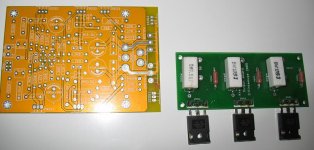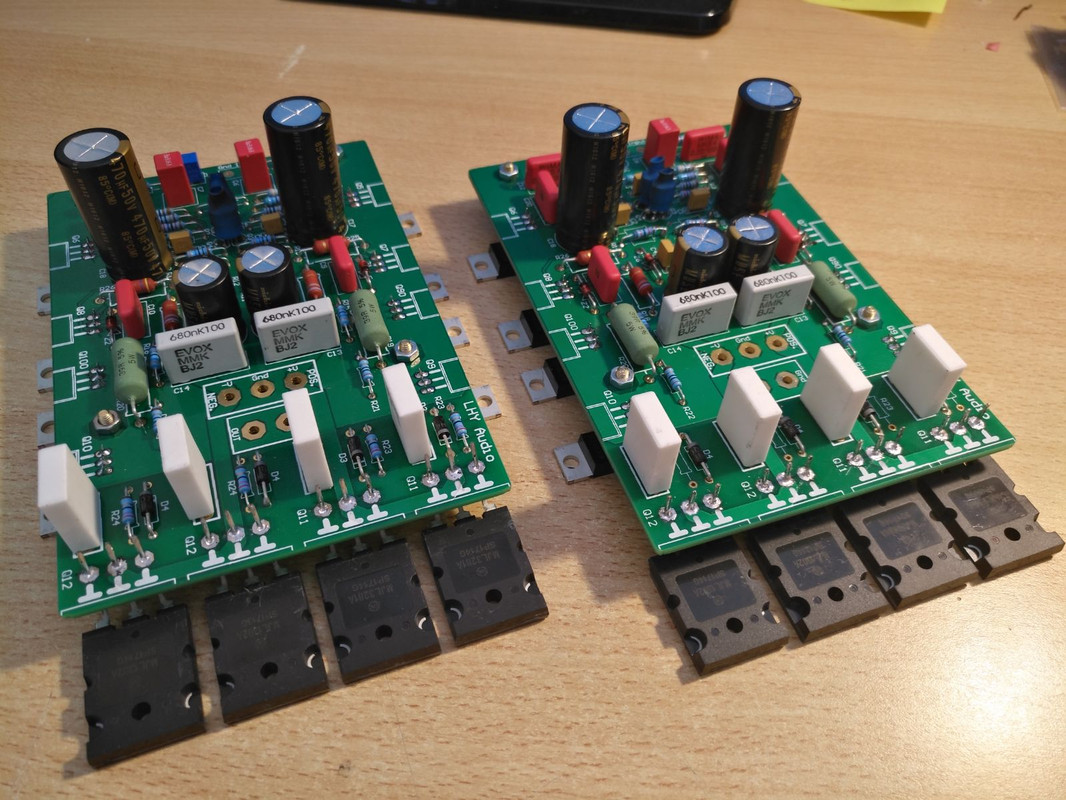
A very interesting variant of the darTZeel NHB-108 clone with two pairs of power transistors, for each PCB, that I just finished making.
Clearly having the same driver stage as the normal version, the output power is substantially identical, but the power amps working in a zone of greater linearity, return a register of "bass" with the same speed and articulation of the normal version, but much more dynamic and impact.
The changes I have made are as follows:
1) for a more suitable drive of the two pairs of power amps, the replacement of the two 5.1 V Zener diodes Z1 and Z2 of the "Constant Current Generator" of the driver stage originates, with others of 6.2V (maximum applicable value to avoid the saturation and distortion of the Q9 and Q10 drivers) to have a better and more adequate drive capacity of the final power stage;
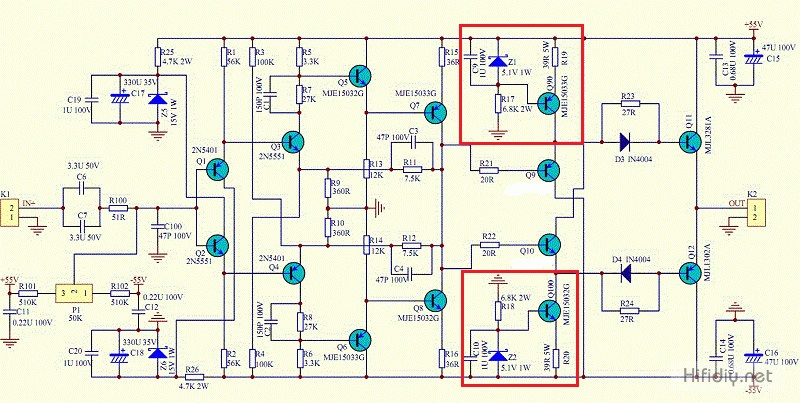
2) The installation of a Supercap with a higher capacity of 30,000 uF between resistances R9 and R10 and mass, replacing the classic 22,000 uF;
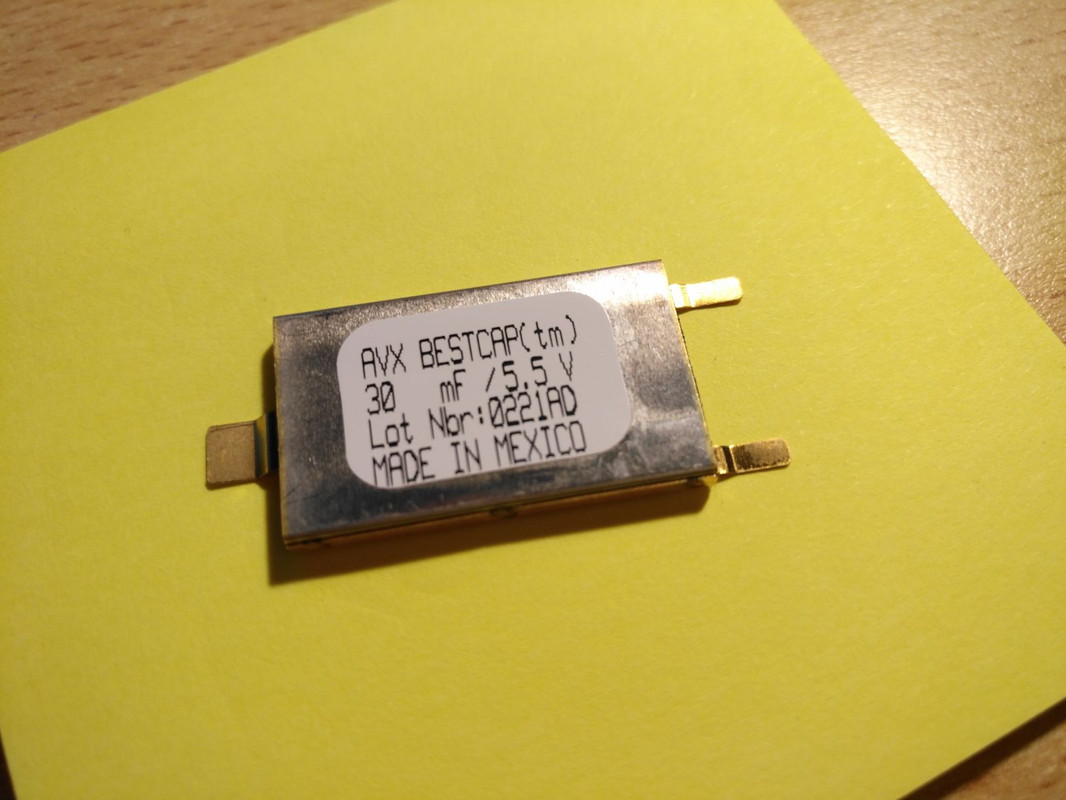
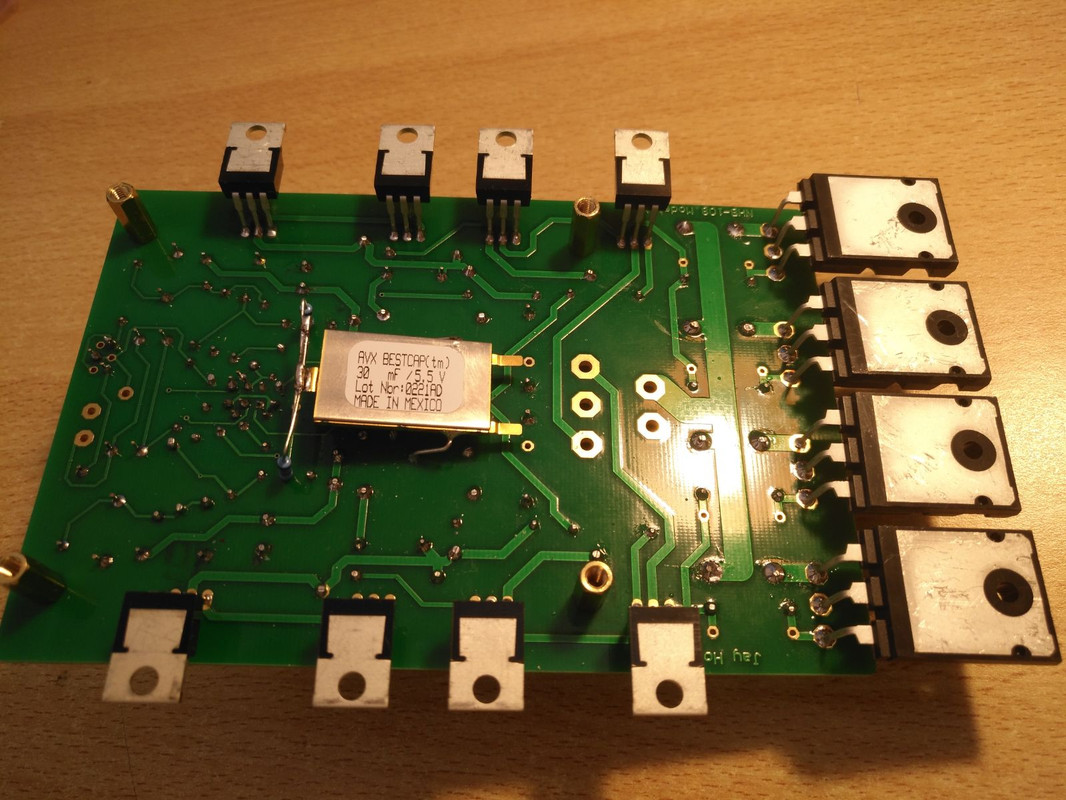
3) The replacement of the four original capacitors of ridiculous quality (C17/C18 330uF/35V and C15/C16 47uF/100V) with others 470uF/50V and 47uF/100V respectively of the excellent and extraordinarily musical NICHIKON Muse UKZ Series;
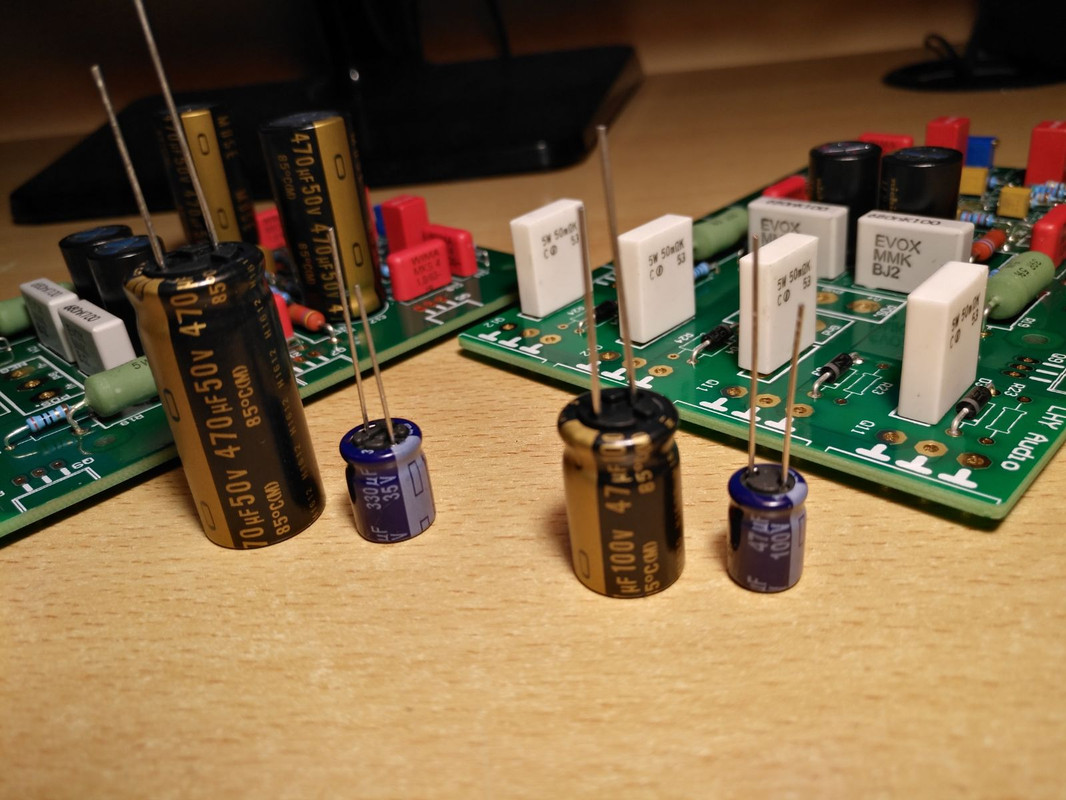
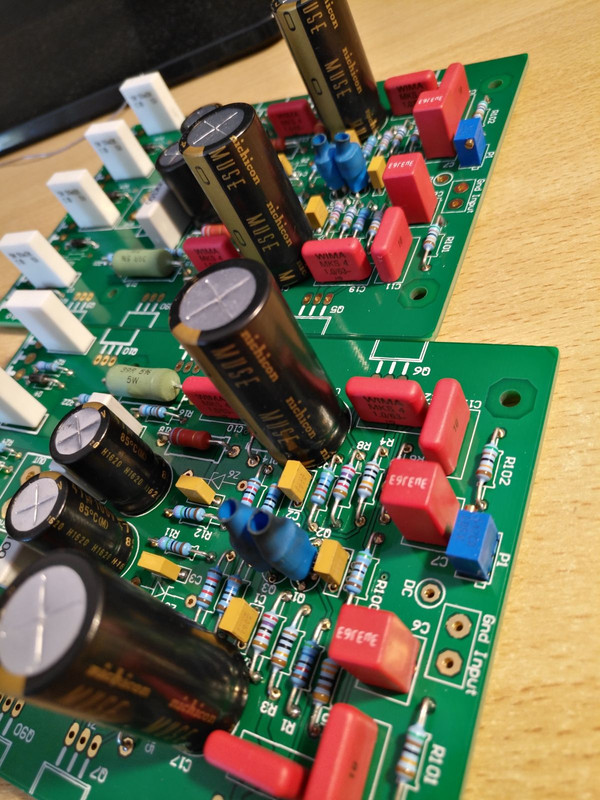
4) And finally, perhaps the most important thing of all for this exceptional circuit layout, the perfect match and coupling for HFE, of the four input 2N5551/2N5401 transistors (Q1, Q2, Q3 and Q4 that you must be careful to physically join with a little thermal paste and the heat-shrink sleeve), in order to reduce the characteristic of this design of the DC Offset output, "dancer" and unstable;
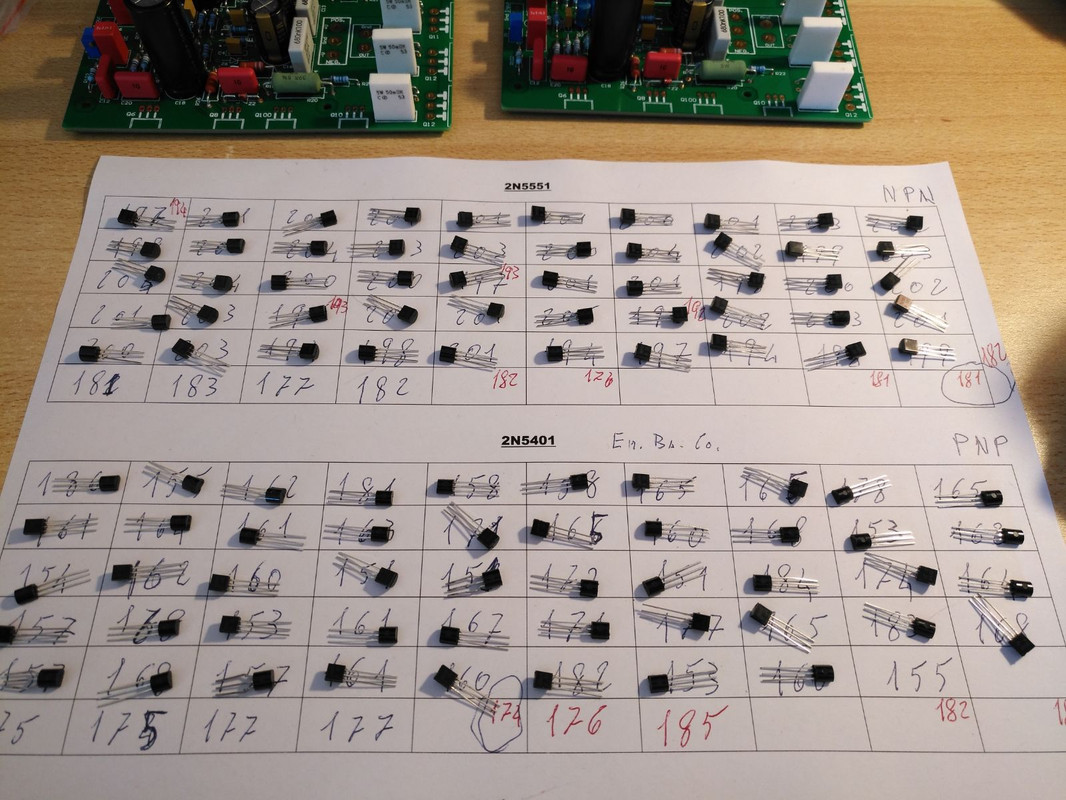
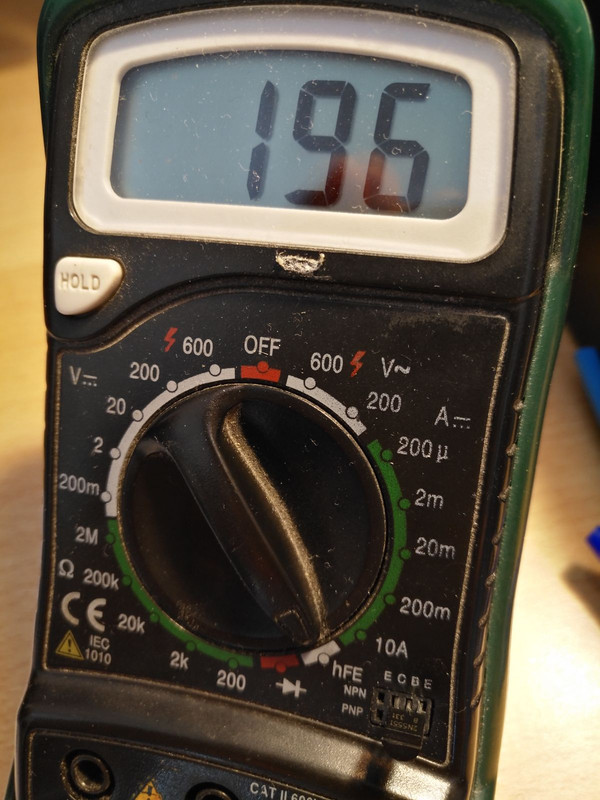
Last edited:
A magnificent audio amplifier and an extraordinary and unique circuit design, that of the dartZeel NHB-108, which with these few but important modifications, will not fail to offer incredible satisfactions with a musicality of extraordinary realism, a spectacular soundstage and a seductive timbric, combined with an exceptional sense of rhythm, speed with an extension and dynamics from absolute record, on the register of medium bass and bass.
2) The installation of a Supercap with a higher capacity of 30,000 uF between resistances R9 and R10 and mass, replacing the classic 22,000 uF;
Please explain: have you introduced a cap in this spot in order to reduce the offset? Why such an incredibly high value?
1) for a more suitable drive of the two pairs of power amps, the replacement of the two 5.1 V Zener diodes Z1 and Z2 of the "Constant Current Generator" of the driver stage originates, with others of 6.2V (maximum applicable value to avoid the saturation and distortion of the Q9 and Q10 drivers) to have a better and more adequate drive capacity of the final power stage;
Nice build !
What's the bias of the output stage?
Which values for base and emitter resistors of the output transistors did you use ?
Regards,
Danny
This 4 output transistors Chinese design is masturbation of original design and idea.
Main concept was to use ONLY 2 transistors to avoid degradation of propagation time delay uniformity.
Second thing is that here is no resistors on output in between speaker and transistors. This also improve speaker control.
The only proper way to use 4 output transistors is to make 2 separate outputs, lets say one pair for MIDs, and second one for HIs
Transistor matching is useless. 2N5551/2N5401 will not act the same when temperature is increasing no mater what you do. The only way is to keep it stable is to use SNCP capacitor and keep stable amplifiers temperature when its warmed up.
Main concept was to use ONLY 2 transistors to avoid degradation of propagation time delay uniformity.
Second thing is that here is no resistors on output in between speaker and transistors. This also improve speaker control.
The only proper way to use 4 output transistors is to make 2 separate outputs, lets say one pair for MIDs, and second one for HIs
Transistor matching is useless. 2N5551/2N5401 will not act the same when temperature is increasing no mater what you do. The only way is to keep it stable is to use SNCP capacitor and keep stable amplifiers temperature when its warmed up.
Please explain: have you introduced a cap in this spot in order to reduce the offset? Why such an incredibly high value?
Yes, I confirm, the purpose of that capacitor, by intervening on the current feedback network, is to contain the variations of the DC Output Offset Voltages.
Very often the layout of clone NHB-108 is associated with a servo DC card, aimed at solving the problem of the DC OffSet variable output, but its intervention, heavily compromises the great musicality of this amplifier.
The installation of the SuperCap in order to decouple the DC network of intermediate feedback to ground, is an effective alternative solution, much less invasive on the musicality of the circuit design of this amplifier, compared to the DC Servo card.
Obviously, the interaction of the feedback network, directly on the second pair of transistors intended for the delicate phase of voltage preamplification, requires that the larger the capacitance of the capacitor installed and the lower the frequency cut made by the installation of the SuperCap.
Normally there is a capacity of 22,000 uF, but I wanted to experiment with an increase of 40%.
And the results have been very positive and appreciable.
Nice build !
What's the bias of the output stage?
Which values for base and emitter resistors of the output transistors did you use ?
Regards,
Danny
Thanks Danny.
The static polarisation network of the four power transistors is essentially identical to that of the two versions.
One 27 Ohm resistor on the Base (parallel to one diode) of each final BJT, with the addition of a 0.5 Ohm/5 Watt ceramic resistor on each of the individual Emitters.
This 4 output transistors Chinese design is masturbation of original design and idea.
Everyone is free to think as they like, including that the design with 4 power transistors is a fun erotic interlude
Main concept was to use ONLY 2 transistors to avoid degradation of propagation time delay uniformity.
This is true and I personally believe and have always believed that amplifiers with a single pair of amps have a balance, timing and musicality with ... an extra gear.
But apart from the fact that its designer d'Hervé Delétraz, in the NHB-458 power amp, maintaining the same "diamond" circuit and global Zero FeedBack, still used more output power amp pairs, the use of two pairs of power amps significantly reduced perhaps the only weak point of the NHB-108 circuit, that of a bass without the necessary impact and macrodynamics.
Second thing is that here is no resistors on output in between speaker and transistors. This also improve speaker control.
The 0.5 Ohm anti-inductive ceramic resistors alter the dumping factor of the amplifier in an absolutely marginal way, on the other hand the four power amps working in the greater linearity zone also and above all guarantee a more extended, fast, articulated and high-impact bass performance, which is objectively missing in the version two pairs of power amps I have been making and owning for more than two years and which I can say I know very well.
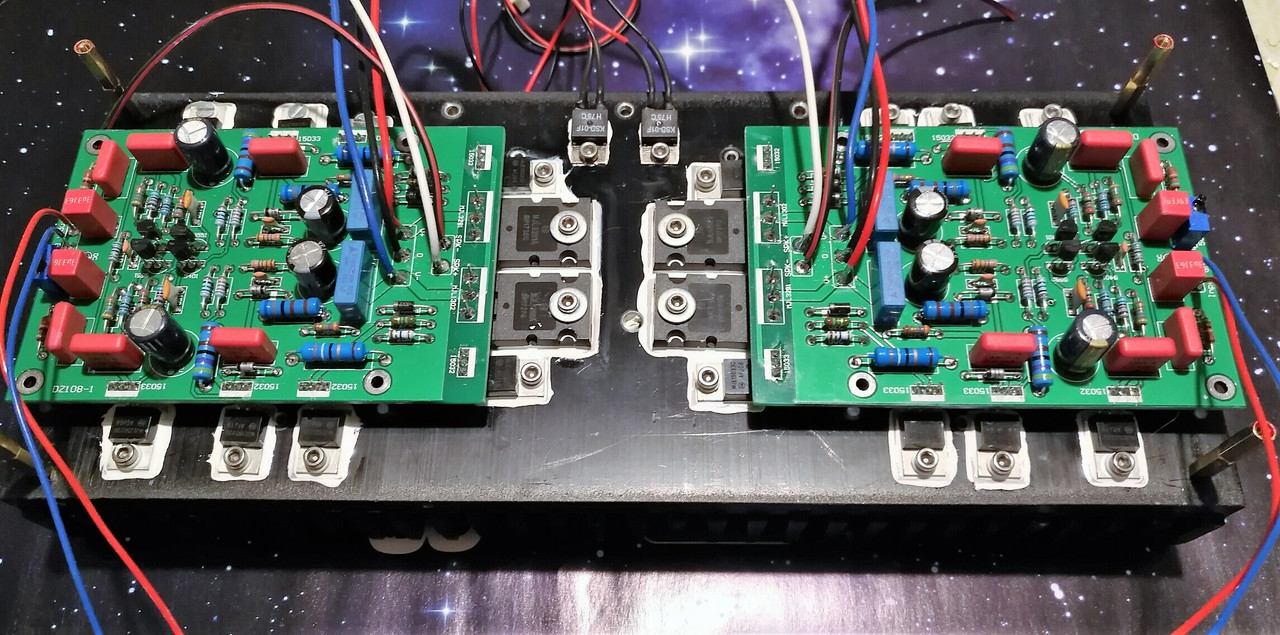
The only proper way to use 4 output transistors is to make 2 separate outputs, lets say one pair for MIDs, and second one for HIs
Personally, I don't see this as a solution, because it doesn't provide a solution for a more generous mid-bass supply, but only an expensive doubling of circuits and electronics.
Transistor matching is useless. 2N5551/2N5401 will not act the same when temperature is increasing no mater what you do.
It may be like you say, but after matching exactly the complementary transistors, the OffSet DC output dropped 40mV on one channel and 30/35mV on the other channel respectively, with absolutely no thought for any speaker.
And now I've even thought of installing a microswitches to bypass the two Supercaps.
The only way is to keep it stable is to use SNCP capacitor and keep stable amplifiers temperature when its warmed up.
Maybe they are not the only systems, however the use of SuperCap and the careful thermal stabilization, also by means of an adequate forced ventilation system, in particular of the first pair of input transistors, remain the best systems to make the output DC OffSet much less variable.
It is not by chance that the Q9 and Q10 drivers are managed on their emitters by two "Constant current generators" which, in addition to variations in supply voltage, make them stable even at temperature drifts, while all the other transistors are under the feedback network which stabilises them even at temperature.
Last edited:
UL, thanks for the detailed explanation of your mods.
There always seems to be a compromise between a single and multiple pairs in the outputs, depending on your speakers and taste.
My only suggestion would be towards better sounding resistors and possibly a lower value. Perhaps Caddock MP930, 0.25R.
There always seems to be a compromise between a single and multiple pairs in the outputs, depending on your speakers and taste.
My only suggestion would be towards better sounding resistors and possibly a lower value. Perhaps Caddock MP930, 0.25R.
One 27 Ohm resistor on the Base (parallel to one diode) of each final BJT, with the addition of a 0.5 Ohm/5 Watt ceramic resistor on each of the individual Emitters.
0.5 ohm is rather high for the emitter resistors, 0.22 or 0.25 (0.5//0.5) gives a higher damping factor, more controlled bass.
Regards,
Danny
Maybe they are not the only systems, however the use of SuperCap and the careful thermal stabilization, also by means of an adequate forced ventilation system, in particular of the first pair of input transistors, remain the best systems to make the output DC OffSet much less variable.
No need any forced ventilation or other crap like active servo module. Separate power supply per channel and SNCP does all the trick. Its enough to have large enough aluminum heatsink. Do few calibrations and job done. Idle: +-10mw
@ ultima legione
May I ask where did you get the PC board for the 2 pair transistors?
Thank you!
vinshineaudio
The person responsible for business relations is Mr. Alvin, extremely kind and professional, to whom it is sufficient to send an e-mail request.
Also consider that of the same NHB-108 clone board with a double pair of power amps (of excellent quality and with a selected set of components), there are four different versions, obviously with different costs:
- pre-assembled and tested or with loose components to be welded,
- with or without the two 22,000 uF SuperperCaps.
0.5 ohm is rather high for the emitter resistors, 0.22 or 0.25 (0.5//0.5) gives a higher damping factor, more controlled bass.
Regards,
Danny
Yes, as also highlighted by @analog_sa, that's something I had overlooked.
Thank you both for your valuable reflection.
Pino
Last edited:
No need any forced ventilation or other crap like active servo module. Separate power supply per channel and SNCP does all the trick. Its enough to have large enough aluminum heatsink. Do few calibrations and job done. Idle: +-10mw
Perfect!!
A double stage monaural power supply, for a total of 800VA and a voltage +/- 40 Vac, is what I had already taken into account.
Thanks.
vinshineaudio
The person responsible for business relations is Mr. Alvin, extremely kind and professional, to whom it is sufficient to send an e-mail request.
Also consider that of the same NHB-108 clone board with a double pair of power amps (of excellent quality and with a selected set of components), there are four different versions, obviously with different costs:
- pre-assembled and tested or with loose components to be welded,
- with or without the two 22,000 uF SuperperCaps.
Hi
Thank you
I already have PC boards for the single pair I wish I could have the one with 3 pairs.
I am only interested in bare (empty) PC board I collected most of the parts also I just placed the order for a pair supper cap.
Do you think they sell only bare PC boards with the 3 pairs power transistors otherwise I will hard wire my single type to a 3 paired-type. It will be messy but what can I do.
I tried from China directly but I am no longer able to login to Taobao.
Thanks one more time
Greetings
Hi
Thank you
I already have PC boards for the single pair I wish I could have the one with 3 pairs.
I am only interested in bare (empty) PC board I collected most of the parts also I just placed the order for a pair supper cap.
Do you think they sell only bare PC boards with the 3 pairs power transistors otherwise I will hard wire my single type to a 3 paired-type. It will be messy but what can I do.
I tried from China directly but I am no longer able to login to Taobao.
Thanks one more time
Greetings
Taobao is a site reserved only for Chinese and it is really impossible to make purchases from foreign countries.
Through Vishine Audio, you can definitely purchase the four power amp version of the NHB-108 clone from LHY Audio.
For the version with six power amps, I'm not sure.
However, carefully consider the circumstance and appropriateness of the three-pair final version.
We here in Italy are a team of enthusiasts and designers, of about ten people, who have been working on this layout for about two years, and after various versions made, tested and carefully compared, we are convinced that the most balanced version, performing and musical, remains the one with two pairs of power amps.
On the three drivers one, you should carefully re-evaluate the drive, bias and energy dissipation balance of the Q9 and Q10 drivers.
Last edited:
My idea to combine these PC boards somehow. I know it would be better to get one PC board with 3 pairs of power transistors (I can use 2 pairs with that also). Of course, if I could get a decent priced PC board I may invest into that, at this moment I don't know other option.
I do not want to buy populated PC boards when I already invested a lot of fund into parts and I know the transistors I use are direct from ON Semi.
Do they sell unstuffed PC boards for a reasonable price?
I have 4 of the output PC boards just too complicated to wire them properly.
I will try my best
I do not want to buy populated PC boards when I already invested a lot of fund into parts and I know the transistors I use are direct from ON Semi.
Do they sell unstuffed PC boards for a reasonable price?
I have 4 of the output PC boards just too complicated to wire them properly.
I will try my best
Attachments
- Home
- Amplifiers
- Solid State
- Dartzeel amp schematic - build this?
